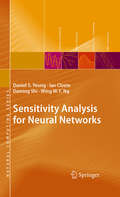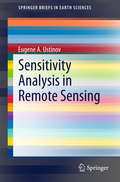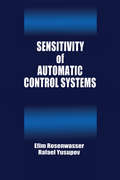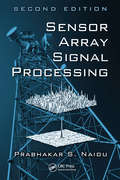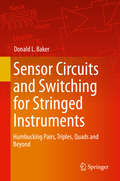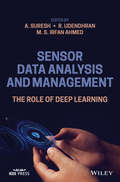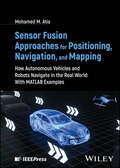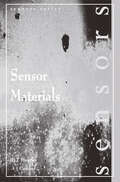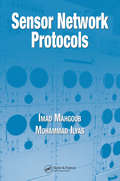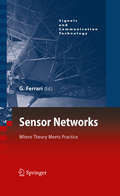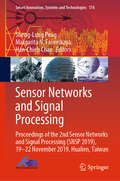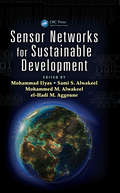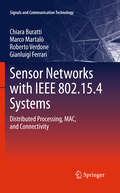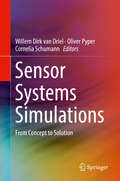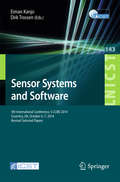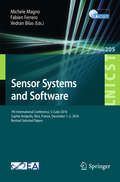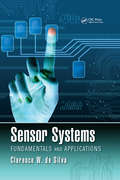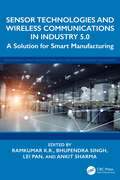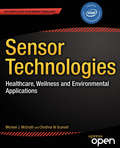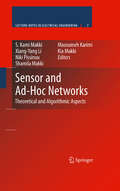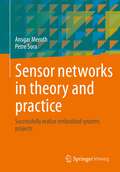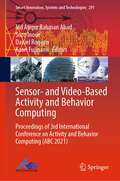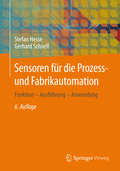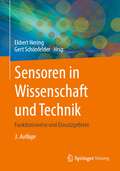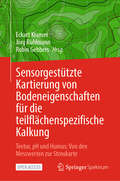- Table View
- List View
Sensitivity Analysis for Neural Networks
by Wing W. Ng Daming Shi Ian Cloete Daniel S. YeungArtificial neural networks are used to model systems that receive inputs and produce outputs. The relationships between the inputs and outputs and the representation parameters are critical issues in the design of related engineering systems, and sensitivity analysis concerns methods for analyzing these relationships. Perturbations of neural networks are caused by machine imprecision, and they can be simulated by embedding disturbances in the original inputs or connection weights, allowing us to study the characteristics of a function under small perturbations of its parameters. This is the first book to present a systematic description of sensitivity analysis methods for artificial neural networks. It covers sensitivity analysis of multilayer perceptron neural networks and radial basis function neural networks, two widely used models in the machine learning field. The authors examine the applications of such analysis in tasks such as feature selection, sample reduction, and network optimization. The book will be useful for engineers applying neural network sensitivity analysis to solve practical problems, and for researchers interested in foundational problems in neural networks.
Sensitivity Analysis in Remote Sensing
by Eugene A. UstinovThis book contains a detailed presentation of general principles of sensitivity analysis as well as their applications to sample cases of remote sensing experiments. An emphasis is made on applications of adjoint problems, because they are more efficient in many practical cases, although their formulation may seem counterintuitive to a beginner. Special attention is paid to forward problems based on higher-order partial differential equations, where a novel matrix operator approach to formulation of corresponding adjoint problems is presented. Sensitivity analysis (SA) serves for quantitative models of physical objects the same purpose, as differential calculus does for functions. SA provides derivatives of model output parameters (observables) with respect to input parameters. In remote sensing SA provides computer-efficient means to compute the jacobians, matrices of partial derivatives of observables with respect to the geophysical parameters of interest. The jacobians are used to solve corresponding inverse problems of remote sensing. They also play an important role already while designing the remote sensing experiment, where they are used to estimate the retrieval uncertainties of the geophysical parameters with given measurement errors of the instrument, thus providing means for formulations of corresponding requirements to the specific remote sensing instrument. If the quantitative models of geophysical objects can be formulated in an analytic form, then sensitivity analysis is reduced to differential calculus. But in most cases, the practical geophysical models used in remote sensing are based on numerical solutions of forward problems - differential equations with initial and/or boundary conditions. As a result, these models cannot be formulated in an analytic form and this is where the methods of SA become indispensable. This book is intended for a wide audience. The beginners in remote sensing could use it as a single source, covering key issues of SA, from general principles, through formulation of corresponding linearized and adjoint problems, to practical applications to uncertainty analysis and inverse problems in remote sensing. The experts, already active in the field, may find useful the alternative formulations of some key issues of SA, for example, use of individual observables, instead of a widespread use of the cumulative cost function. The book also contains an overview of author's matrix operator approach to formulation of adjoint problems for forward problems based on the higher-order partial differential equations. This approach still awaits its publication in the periodic literature and thus may be of interest to readership across all levels of expertise.
Sensitivity of Automatic Control Systems (Control Series #2)
by Efim Rozenwasser Rafael YusupovAlthough it arose much earlier in a variety of contexts, sensitivity theory became an independent branch of science in the sixties. Since then, researchers from around the world have continued to make great strides in both the theory and its applications. However, much of the work of Russian scientific schools and specialists remain unknown in the West.Sensitivity of Control Systems summarizes the results of the authors and their disciples in sensitivity theory, addressing the basic notions of the theory and the problem of selecting technical parameters of systems. The authors formulate problems for actual technical systems and their models, and establish relations between sensitivity theory and classical stability problems. They offer a significant, general theory for investigating the sensitivity of boundary problems and use elements of this theory for sensitivity analysis of solutions to nonlinear programming and variational calculus problems, as well as oscillatory processes. The book also presents general investigation methods for discontinuous systems, including those described by operator models.Full of powerful new methods and results, this book offers a unique opportunity for those in theoretical investigation and in the design, testing, and exploitation of various control systems to explore the work of Russia's leading researchers in sensitivity theory. Furthermore, its techniques for parametric perturbation investigation, Sensitivity of Control Systems will prove useful in fields outside of control theory, including oscillation theory, motion dynamics, and mathematical economy.
Sensor Array Signal Processing
by Prabhakar S. NaiduSince publication of the first edition of Sensor Array Signal Processing in 2000, the field it heralded has come of age. Sensor arrays helped usher in the age of wireless communication by meeting the increasing capacity requirements of ever growing wireless networks, but that is only one example of the number of uses served by this valuable te
Sensor Circuits and Switching for Stringed Instruments: Humbucking Pairs, Triples, Quads and Beyond
by Donald L. BakerThis book presents new methods of circuit design for guitar electronics, based directly upon U.S. Non-Provisional Patent Applications. By systematic construction of unique series-parallel circuit topologies, the author shows how many series-parallel circuits are possible, including non-matched single-coil pickups, humbucking pickups, and humbucking combinations of matched single-coil pickups. This allows designers to avoid unnecessary and confusing duplicate circuits in pickup switching systems. It shows how electromechanical switches cannot produce the maximum number of tones for more than 2 or 3 pickups. Thus the author discloses an efficient micro-controller and cross-point switch architecture to replace mechanical switches, and allow access to the maximum number of tones. The discussion continues, developing humbucking circuits for odd numbers of matched single-coil pickups, extendable to any odd or even number, greater than 1, using a simplified switching system with very simple rules. It abandons some tones in favor of producing all-humbucking and unique tones, no matter what the switching choice. The author discloses both mechanical and digital switching versions. Then, based on using humbucking basis vectors, the author discloses variable-gain circuits that duplicate all possible switched humbucking tone circuits, and produces all the continuous tone gradations in between. The presentation includes analog and digitally controlled systems. The object of all the disclosures: give the guitarist or pianist a system which allows going from bright to warm tones and back, without ever needing to know which pickups are used in what combination.
Sensor Data Analysis and Management: The Role of Deep Learning
by A. Suresh R. Udendhran M.S. Irfan AhmedDiscover detailed insights into the methods, algorithms, and techniques for deep learning in sensor data analysis Sensor Data Analysis and Management: The Role of Deep Learning delivers an insightful and practical overview of the applications of deep learning techniques to the analysis of sensor data. The book collects cutting-edge resources into a single collection designed to enlighten the reader on topics as varied as recent techniques for fault detection and classification in sensor data, the application of deep learning to Internet of Things sensors, and a case study on high-performance computer gathering and processing of sensor data. The editors have curated a distinguished group of perceptive and concise papers that show the potential of deep learning as a powerful tool for solving complex modelling problems across a broad range of industries, including predictive maintenance, health monitoring, financial portfolio forecasting, and driver assistance. The book contains real-time examples of analyzing sensor data using deep learning algorithms and a step-by-step approach for installing and training deep learning using the Python keras library. Readers will also benefit from the inclusion of: A thorough introduction to the Internet of Things for human activity recognition, based on wearable sensor data An exploration of the benefits of neural networks in real-time environmental sensor data analysis Practical discussions of supervised learning data representation, neural networks for predicting physical activity based on smartphone sensor data, and deep-learning analysis of location sensor data for human activity recognition An analysis of boosting with XGBoost for sensor data analysis Perfect for industry practitioners and academics involved in deep learning and the analysis of sensor data, Sensor Data Analysis and Management: The Role of Deep Learning will also earn a place in the libraries of undergraduate and graduate students in data science and computer science programs.
Sensor Fusion Approaches for Positioning, Navigation, and Mapping: How Autonomous Vehicles and Robots Navigate in the Real World: with MATLAB examples
by Mohamed M. AtiaUnique exploration of the integration of multi-sensor approaches in navigation and positioning technologies. Sensor Fusion Approaches for Positioning, Navigation, and Mapping discusses the fundamental concepts and practical implementation of sensor fusion in positioning and mapping technology, explaining the integration of inertial sensors, radio positioning systems, visual sensors, depth sensors, radar measurements, and LiDAR measurements. The book includes case studies on ground wheeled vehicles, drones, and wearable devices to demonstrate the presented concepts. To aid in reader comprehension and provide readers with hands-on training in sensor fusion, pedagogical features are included throughout the text: block diagrams, photographs, plot graphs, examples, solved problems, case studies, sample codes with instruction manuals, and guided tutorials. Rather than simply addressing a specific sensor or problem domain without much focus on the big picture of sensor fusion and integration, the book utilizes a holistic and comprehensive approach to enable readers to fully grasp interrelated concepts. Written by a highly qualified author, Sensor Fusion Approaches for Positioning, Navigation, and Mapping discusses sample topics such as: Mathematical background, covering linear algebra, Euclidean space, coordinate frames, rotation and transformation, quaternion, and lie groups algebra. Kinematics of rigid platforms in 3D space, covering motion modeling in rotating and non-rotating frames and under gravity field, and different representations of position, velocity, and orientation. Signals and systems, covering measurements, and noise, probability concepts, random processes, signal processing, linear dynamic systems, and stochastic systems. Theory, measurements, and signal processing of state-of-the-art positioning and mapping sensors/systems covering inertial sensors, radio positioning systems, ranging and detection sensors, and imaging sensors. State Estimation and Sensor Fusion methods covering filtering-based methods and learning-based approaches. A comprehensive introductory text on the subject, Sensor Fusion Approaches for Positioning, Navigation, and Mapping enables students to grasp the fundamentals of the subject and support their learning via ample pedagogical features. Practicing robotics and navigation systems engineers can implement included sensor fusion algorithms on practical platforms.
Sensor Materials (Series In Sensors Ser.)
by P.T Moseley J CrockerBecause artificial sensors have assumed a major role in both domestic and industrial settings, the development of new technologies continues. Sensor Materials is the first publication that approaches the subject of sensors from a materials standpoint and provides a global overview of the field in a single, compact, and accessible volume.Introductory chapters present a solid introduction to the classification of sensors and the various properties of materials used in sensing. The subsequent chapters deal with specific areas of sensor materials, including metal, semiconductor, dielectric, solid electrolytic, magnetic, fiber optics, radiant, and biological materials. In addition, there is substantial bibliographic information that provides a source of published research literature for each sensor.
Sensor Network Protocols
by Mohammad Ilyas Imad MahgoubSensor networks continue to grow in importance for modern communication networks. Communication protocols are at the core of these networks, determining their ability to function, their capabilities, and the environments in which they are able to operate. In chapters carefully selected from the popular Handbook of Sensor Networks, Sensor Network Protocols supplies a sharply focused reference on protocols, security, data processing, and energy management in communication sensor networks that is ideal for specialists in the field. Providing a succinct guide to the protocols currently used in advanced sensor networks, this book focuses on four main areas: routing protocols; data gathering and processing; security and reliability; and energy management. The book opens with a survey of the challenges and opportunities facing the field. Then, expert contributors authoritatively discuss routing technologies, next-generation enabling technologies, comparative study of energy-efficient protocols for wireless sensor networks, techniques to reduce computation and communication energy consumption, energy-aware routing, localized algorithms for sensor networks, and much more.Sensor Network Protocols details the techniques and technologies that are at the heart of modern sensor networks. It is an ideal reference for anyone interested in designing, planning, or building emerging sensor and communications networks.
Sensor Networks
by Gianluigi FerrariThis book collects very recent results in the realm of sensor networking. In particular, it links the theory of sensor networking with practical and implementation aspects. Such, it highlights how sensor networking represents a very interesting research/application area, allowing a researcher to apply his theories and a practitioner to "see" the theories behind his/her used technologies.
Sensor Networks and Signal Processing: Proceedings of the 2nd Sensor Networks and Signal Processing (SNSP 2019), 19-22 November 2019, Hualien, Taiwan (Smart Innovation, Systems and Technologies #176)
by Margarita N. Favorskaya Han-Chieh Chao Sheng-Lung PengThis book offers a collection of high-quality research papers presented at the 2nd International Conference on Sensor Networks and Signal Processing (SNSP 2019), held in Taiwan on November 19–22, 2019. It presents novel contributions in the areas of sensor and actuator networks, wireless networks, networking and protocols, security and privacy, wireless communications, distributed algorithms, Internet of Things, system modeling and performance analysis, fault tolerance/diagnostics, information management, data mining and analysis, embedded systems design, signal theory, signal and image processing, detection and estimation, spectral analysis, software developments, pattern recognition, data processing, remote sensing, big data, machine learning, information and coding theory, and industrial applications.
Sensor Networks for Sustainable Development
by Mohammad Ilyas el-Hadi M. Aggoune Sami Alwakeel Mohammed AlwakeelRecent advances in technology and manufacturing have made it possible to create small, powerful, energy-efficient, cost-effective sensor nodes for specialized telecommunication applications—nodes "smart" enough to be capable of adaptation, self-awareness, and self-organization. Sensor Networks for Sustainable Development examines sensor network technologies that increase the quality of human life and encourage societal progress with minimal effect on the earth’s natural resources and environment. Organized as a collection of articles authored by leading experts in the field, this valuable reference captures the current state of the art and explores applications where sensor networks are used for sustainable development in: Agriculture Environment Energy Healthcare Transportation Disaster management Beneficial to designers and planners of emerging telecommunication networks, researchers in related industries, and students and academia seeking to learn about the impact of sensor networks on sustainable development, Sensor Networks for Sustainable Development provides scientific tutorials and technical information about smart sensor networks and their use in everything from remote patient monitoring to improving safety on the roadways and beyond.
Sensor Networks with IEEE 802.15.4 Systems
by Roberto Verdone Gianluigi Ferrari Marco Martalo' Chiara BurattiThis book presents a simple, yet complete, approach to the design and performance analysis of distributed processing algorithms and techniques suitable for IEEE 802.15.4 networks. In particular, the book focuses on the bottom two layers of the ISO/OSI stack (Physical and Medium Access Control), discussing also a few issue related to routing. The book is a the synergistic combination of signal processing aspects on the one hand and MAC and connectivity issues on the other hand. The goal of the book is to clearly link physical layer aspects with medium access and topology aspects, in order to provide the reader with a clear understanding of how to approach the design of proper distributed signal processing and medium access algorithms in this context.
Sensor Systems Simulations: From Concept to Solution
by Willem Dirk van Driel Oliver Pyper Cornelia SchumannThis book describes for readers various technical outcomes from the EU-project IoSense. The authors discuss sensor integration, including LEDs, dust sensors, LIDAR for automotive driving and 8 more, demonstrating their use in simulations for the design and fabrication of sensor systems. Readers will benefit from the coverage of topics such as sensor technologies for both discrete and integrated innovative sensor devices, suitable for high volume production, electrical, mechanical, security and software resources for integration of sensor system components into IoT systems and IoT-enabling systems, and IoT sensor system reliability.Describes from component to system level simulation, how to use the available simulation techniques for reaching a proper design with good performance;Explains how to use simulation techniques such as Finite Elements, Multi-body, Dynamic, stochastics and many more in the virtual design of sensor systems;Demonstrates the integration of several sensor solutions (thermal, dust, occupancy, distance, awareness and more) into large-scale system solutions in several industrial domains (Lighting, automotive, transport and more);Includes state-of-the-art simulation techniques, both multi-scale and multi-physics, for use in the electronic industry.
Sensor Systems and Software
by Eiman Kanjo Dirk TrossenThis book constitutes the thoroughly refereed post-conference proceedings of the 5th International Conference on Sensor Systems and Software, S-Cube 2014, held in Coventry, UK, in October 2014. The 12 revised full papers presented were selected from 16 submissions and cover technologies for wireless sensor networks, including security protocols, middleware, analysis tools and frameworks.
Sensor Systems and Software
by Michele Magno Fabien Ferrero Vedran BilasThis book constitutes the thoroughly refereed post-conference proceedings of the 7th EAI International Conference on Sensor Systems and Software, S-Cube 2016, held in Sophia Antipolis, Nice, France, in December 2016. The 15 revised full papers and 5 invited papers cover technologies for wireless sensor networks, smart city and industry 4. 0 applications, and smart sensing.
Sensor Systems: Fundamentals and Applications
by Clarence W. de SilvaThis book covers sensors and multiple sensor systems, including sensor networks and multi-sensor data fusion. It presents the physics and principles of operation and discusses sensor selection, ratings and performance specifications, necessary hardware and software for integration into an engineering system and signal processing and data analysis. Additionally, it discusses parameter estimation, decision making and practical applications. Even though the book has all the features of a course textbook, it also contains a wealth of practical information on the subject.
Sensor Technologies and Wireless Communications in Industry 5.0: A Solution for Smart Manufacturing (Innovations in Smart Manufacturing for Long-Term Development and Growth)
by Ramkumar K.R., Bhupendra Singh, Lei Pan, and Ankit SharmaThe book explores the Internet of Things (IoT) landscape, focusing on sensor technologies and wireless sensor communications. It discusses challenges in establishing interconnected sensors, network connectivity, longevity, and strategies for sustaining sensor networks in dynamic industrial environments. The book also discusses issues like tracking objects, geolocation, and network coverage optimization and highlights the impact of artificial intelligence in sensor networks and the synergies between sensor technologies and wireless communications in Industry 5.0.Sensor Technologies and Wireless Communications in Industry 5.0: A Solution for Smart Manufacturing provides a thorough examination of the Internet of Things, with a specific focus on sensor technologies and wireless sensor communications. It delves into the latest advancements in sensor precision, communication protocols, and real-world applications, offering readers cutting-edge insights into the rapidly evolving IoT landscape. Recognizing the interdisciplinary nature of IoT, this book serves as a bridge between technology, engineering, and data science. It aligns itself with the Industry 5.0 paradigm and features contributions from top researchers in the field. By anticipating emerging trends and future directions within the IoT field, this book provides readers with valuable insights into the potential trajectories of sensor technologies and wireless communications.Designed as a research tool and an educational resource for academic institutions, this book is essential for researchers, students, and educators seeking up-to-date information on IoT technologies.
Sensor Technologies: Healthcare, Wellness and Environmental Applications
by Michael J. Mcgrath Cliodhna Ní ScanaillSensor Technologies: Healthcare, Wellness and Environmental Applications explores the key aspects of sensor technologies, covering wired, wireless, and discrete sensors for the specific application domains of healthcare, wellness and environmental sensing. It discusses the social, regulatory, and design considerations specific to these domains. The book provides an application-based approach using real-world examples to illustrate the application of sensor technologies in a practical and experiential manner. The book guides the reader from the formulation of the research question, through the design and validation process, to the deployment and management phase of sensor applications. The processes and examples used in the book are primarily based on research carried out by Intel or joint academic research programs. "Sensor Technologies: Healthcare, Wellness and Environmental Applications provides an extensive overview of sensing technologies and their applications in healthcare, wellness, and environmental monitoring. From sensor hardware to system applications and case studies, this book gives readers an in-depth understanding of the technologies and how they can be applied. I would highly recommend it to students or researchers who are interested in wireless sensing technologies and the associated applications. " Dr. Benny Lo Lecturer, The Hamlyn Centre, Imperial College of London "This timely addition to the literature on sensors covers the broad complexity of sensing, sensor types, and the vast range of existing and emerging applications in a very clearly written and accessible manner. It is particularly good at capturing the exciting possibilities that will occur as sensor networks merge with cloud-based ''big data'' analytics to provide a host of new applications that will impact directly on the individual in ways we cannot fully predict at present. It really brings this home through the use of carefully chosen case studies that bring the overwhelming concept of ''big data'' down to the personal level of individual life and health. " Dermot Diamond Director, National Centre for Sensor Research, Principal Investigator, CLARITY Centre for Sensor Web Technologies, Dublin City University "Sensor Technologies: Healthcare, Wellness and Environmental Applications takes the reader on an end-to-end journey of sensor technologies, covering the fundamentals from an engineering perspective, introducing how the data gleaned can be both processed and visualized, in addition to offering exemplar case studies in a number of application domains. It is a must-read for those studying any undergraduate course that involves sensor technologies. It also provides a thorough foundation for those involved in the research and development of applied sensor systems. I highly recommend it to any engineer who wishes to broaden their knowledge in this area!" Chris Nugent Professor of Biomedical Engineering, University of Ulster What you''ll learn The relevant sensing approaches and the hardware and software components required to capture and interpret sensor data. The importance of regulations governing medical devices. A design methodology for developing and deploying successful home- and community-based technologies, supported by relevant case studies. Health, wellness, and environmental sensing applications and how they work. The challenges and future directions of sensing in these domains. Who this book is for Sensor Technologies: Healthcare, Wellness and Environmental Applications is targeted at clinical and technical researchers, engineers, and students who want to understand the current state of the art in sensor applications in these domains. The reader gains a full awareness of the key technical and non-technical challenges that must be addressed in the development of successful end-to-end sensor applications. Real-world examples help give the reader practical insights into the successful development, deployment, and management o...
Sensor and Ad-Hoc Networks
by Xiang-Yang Li Kia Makki S. Kami Makki Niki Pissinou Masoumeh Karimi Shamila MakkiThis book brings together leading researchers and developers in the field of wireless sensor networks to explain the special problems and challenges of the algorithmic aspects of sensor and ad-hoc networks. The book also fosters communication not only between the different sensor and ad-hoc communities, but also between those communities and the distributed systems and information systems communities. The topics addressed pertain to the sensors and mobile environment.
Sensor networks in theory and practice: Successfully realize embedded systems projects
by Ansgar Meroth Petre SoraThe book provides an important foundation for understanding the Internet of Things by offering insight into common networking protocols from the microcontroller world and introducing important sensors and other devices, as well as their use and programming. All concepts shown are illustrated with practical circuit and programming examples from the authors' many years of experience. In addition, open libraries for controlling the devices presented in the book are available for readers to download from the publisher's home page. The second edition includes some new devices, especially in the area of networks, a more detailed description of the operating principles of some sensors as well as further tips and tricks for programming.
Sensor- and Video-Based Activity and Behavior Computing: Proceedings of 3rd International Conference on Activity and Behavior Computing (ABC 2021) (Smart Innovation, Systems and Technologies #291)
by Sozo Inoue Daniel Roggen Md Atiqur Rahman Ahad Kaori FujinamiThis book presents the best-selected research papers presented at the 3rd International Conference on Activity and Behavior Computing (ABC 2021), during 20–22 October 2021. The book includes works related to the field of vision- and sensor-based human action or activity and behavior analysis and recognition. It covers human activity recognition (HAR), action understanding, gait analysis, gesture recognition, behavior analysis, emotion, and affective computing, and related areas. The book addresses various challenges and aspects of human activity recognition—both in sensor-based and vision-based domains. It can be considered as an excellent treasury related to the human activity and behavior computing.
Sensoren für die Prozess- und Fabrikautomation: Funktion - Ausführung - Anwendung
by Stefan Hesse Gerhard SchnellDas inhaltlich erweiterte und in Praxis wie Ausbildung gut aufgenommene Buch bietet einen Überblick über physikalische Grundlagen und Funktionen von Sensoren in der Fabrikautomation. Es ist nach Aufgaben von Sensoren gegliedert und zeigt an vielen Beispielen Wirkungsweise und Anwendung, auch in der Robotik. Für Begriffe der Sensorik wird die englische Übersetzung angegeben. Im Minilexikon werden 264 Fachtermini erklärt.
Sensoren in Wissenschaft und Technik: Funktionsweise und Einsatzgebiete
by Ekbert Hering Gert SchönfelderDas Buch bietet einen umfassenden Überblick über physikalische Grundlagen, Funktionen und Applikationen von Sensoren. Es ist nach den Aufgabenfeldern von Sensoren gegliedert und zeigt anhand typischer Einsatzbeispiele anschaulich deren Anwendung. Sensorisch erfassbare Messgrößen sind z.B. mechanische, dynamische, thermische sowie elektrische und magnetische. Weiterhin werden auch optische und akustische Sensoren in deren Anwendung im Buch detailliert behandelt. Die Sensor-Signale werden aufgenommen, weiterverarbeitet und in Steuersignale für Aktoren umgewandelt. Solche Sensorsysteme werden ebenfalls vorgestellt.
Sensorgestützte Kartierung von Bodeneigenschaften für die teilflächenspezifische Kalkung: Textur, pH und Humus: Von den Messwerten zur Streukarte
by Eckart Kramer Jörg Rühlmann Robin GebbersDieses Open Access Buch vermittelt fundierte Grundlagen und praxisorientierte Anleitungen für die genaue Kartierung von Ackerflächen auf der Grundlage von Bodenparametern wie Textur, pH-Wert und Humusgehalt. Es werden die gegenwärtig bestgeeigneten Kartierungsverfahren beschrieben. Von der Bereinigung der Bodensensordaten bis hin zur Erstellung von Streukarten und der Auswahl des optimalen Kalkdüngers wird jeder Schritt des Prozesses detailliert erklärt. Sämtliche Funktionen und Algorithmen zum Buch sind als “R”-Skripte via Download verfügbar. Mit Hilfe von Beispieldaten und einem Tutorial kann die Prozesskette zur Streukartenerstellung mit der freien Softwareumgebung “R” als Einstieg in mathematische Methoden des Precision Farming, u.a. räumliche Statistik und Entscheidungsunterstützungsalgorithmen, nachvollzogen werden. Darüber hinaus bietet dieses Buch praktische Einblicke in die landwirtschaftliche Praxis, indem es die Bedeutung präziser Bodentexturkarten für eine effiziente Grunddüngung erläutert. Anhand von anschaulichen Praxisbeispielen werden die Auswirkungen ungenauer Bodeninformationen auf die Nährstoffversorgung des Bodens und die Umwelt verdeutlicht. Mit seinem ganzheitlichen Ansatz liefert dieses Buch nicht nur praktische Anleitungen, sondern auch wertvolles Hintergrundwissen zu Fachthemen wie Bodenacidität, Kalkdüngestoffen und Kartierungsmethoden. Es ist ein idealer Begleiter für Landwirt*innen, Berater*innen und Wissenschaftler*innen, die ihre landwirtschaftlichen Praktiken optimieren und ihre Erträge steigern möchten.
